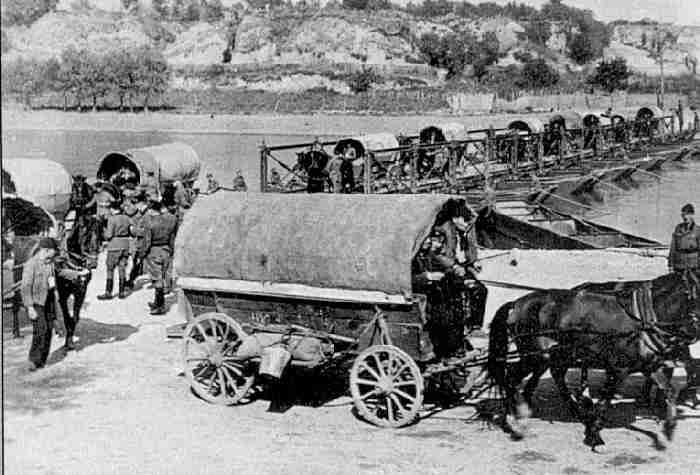
Volksdeutsche in Romania: World War II

Figure 1.--Here Volkdeutsche from Bessarabia are crossing the Prfut River. After the Soviets ceased Bessarabia the NAZIs encouraged them to leave the homes where their ancestors had lived for centuries. Note the boy leading the cart and the German soldiers checking each wagon. Bundesarchiv, Koblenz.
|
Romania which fought with the Allies in World War I, joined the Axis in World War II. We only have limited information at this time on how the the Volkdeutsche fared during World War II. Under the terms of the NAZI-Soviet Non-Agression Pact (August 1938), the NAZIs recognized Soviet rights to Bessarabia, then the eastern province of Romania. We know that the Volkdeutsche in Bessarabia left when the Soviets seized the province from Romania (July 1940). Hitler was not pleased, but did not yet wish to confront Stalin. The NAZIs encouraged the Volkdeutsche who had resided there for centuries to leave rather than stay under Soviet rule. Once safely across the River Prut, however, the Volkdeutsche were not allowed to resettle, but rather confined in camps. I'm not sure what happened to them after the NAIs invaded the Soviet Union (June 1941). Presumably many tried to return to their former homes.
Bessarabia
Bessarabia used to belong to Russia from 1812 till 1918. We have little information about Bessarabia during the Tsarist era. Bessarabia became Romanian territory in 1918 as a result of the turmoil connected with World War I, the Russian Revolution, and the Russian Civil War. Romania fought with the Allies and thus had Allied support as the boundaries of Europe were withdrawn after the War. Germans from the Black Forest had been settling the area since the early 1800s. A treaty was signed between the Soviet Union and Nazi-Germany in 1940 to send "heim ins Reich", (back to Germany)
93 000 Volksdeutsche from Bessarabia.
Under the terms of the NAZI-Soviet Non-Agression Pact (August 1938). Stalin after World War II began proceeded to recover the territories of the old Russian Empire thast had been lost. The NAZIs recognized Soviet rights to Bessarabia, then the eastern province of Romania.
Most of the Volkdeutsche in Bessarabia left when the Soviets seized the province from Romania (July 1940).
NAZI Policy
Hitler was not pleased, but did not yet wish to confront Stalin. That would of course come later. At the time the German Army was in the west, largely in France. Only slowly would the army be moved east and NAZI diplomacy was designed to lull Stalin to think that there relations with the NAZIs were correct.
Bessarabian Volkdeutsche
We have little information about the Volkdeutsche in Romania. We do have informnation about a ethnic German boy born in Bessarabia, Arthur Franz. The NAZIs encouraged the Volkdeutsche who had resided there for centuries to leave rather than stay under Soviet rule. Once safely across the River Prut, however, the Volkdeutsche were not allowed to resettle, but rather confined in camps. I'm not sure what happened to them after the NAIs invaded the Soviet Union (June 1941). Presumably many tried to return to their former homes. TYhey were forced to leave again when the Red Army liberated Bessarabia (1944). The Volkdeutsche ones who remained were later deported to Siberia and Kazakhstan. Part of Bessarabia now belongs to the Ukraine. Several Bessarabia-Germans emigrated to the United States after the War.
Romanian Volldeutsche
These Volksdeutsche from Romania are very different from the "Saxons" who went to Transsylvania in the 12th century, where they founded the cities Kronstadt (Brasov) and Hermannstadt (Sibiu). I have few details on their experience during the War. Unlike the situation in the rest of Eastern Europe, Romanian authorities aloowed most of them to remain after the war. Many decided to return to Germany. Many left when the oppressive communist regime of Ceausescu made life intolerable. Of the 500,000 who once lived there, only about 100 000 are still in Romania. Conditions since the fall of Communism have improved cosiderably.
HBC

Navigate the Boys' Historical Clothing German pages:
[Return to the Main Romanian Volkdeutsche page]
[Return to the Main Volksdeutsche page]
[Return to the Main Romanian World War II page]
[German choirs]
[German movies]
[German school uniforms]
[German royalty]
[German youth groups]
[German sailor suits]
[Lederhosen]
[Ethnic]
[Tights]
[Long stockings]
Navigate the Boys' Historical Clothing Web Site:
[Introduction]
[Activities]
[Bibliographies]
[Biographies]
[Chronology]
[Clothing styles]
[Countries]
[Contributions]
[FAQs]
[German glossaries]
[Satellite sites]
[Tools]
[Boys' Clothing Home]
Created: 4:53 AM 10/12/2004
Last updated: 12:43 AM 2/17/2005



